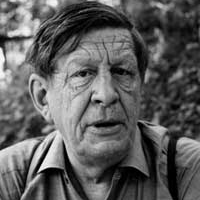In Memory of W.B. Yeats by W.H. Auden: Critical Analysis
In Memory of W. B. Yeats, by W.H. Auden is a modern poem in its imagery, concept and versification. The poem, as its title indicates, is an elegy written to mourn the death of W.B. Yeats, but it is different from the conventional elegy. Traditionally, in an elegy, all nature is represented as mourning the death, here nature is represented as going on its course indifferent and unaffected.

W.H. Auden (1907-1973)
The great poet's death goes unnoticed both by man and nature: human life goes on as usual, and so does nature. Secondly, in the traditional elegy the dead is glorified and his death is said to be a great loss for mankind at large. But Auden does not glorify Yeats. He goes to the extent of calling him 'silly' and further that his poetry could make nothing happen. "Ireland has her madness and her weather still." Thus, Auden reverses the traditional elegiac values and treats them ironically. Although, apparently the poem is an elegy, Auden reverses and departs from the known traditions of elegy. He does not idealize Yeats as a poet or sentimentalize his fate. He proceeds to embody certain general reflections on the art of a poet and the place of poetry in the flux of events, which constitute human history. So the death of Yeats remains at the focus of the poem only to support the peripheral reflections in the poem.
Auden begins this ode with an archetypal image cluster that links winter and death. The setting is desolate and filled with winter, death and negative words, which often are linked by alliteration of d sounds. Alliterating negative words and phrase include: ‘disappeared’ and ‘dad’ (line1), ‘deserted’ (line 2), ‘disfigured’ (line3), ‘dying day’ (line 4), and ‘day’, ‘death’ (line 6). This repetition creates a powerful scene of desolation in which the world’s deadliest time seems to mirror the poet Yeats’ death. In an extended form of personification, the wintering earth itself seems to mourn the loss of the poet.
In addition, Auden makes good use of other extended metaphors by establishing a different central metaphor for almost each stanza in part 1. He compares death to an invading army that takes over Yeats’ whole being in stanza 4. The ‘invasion’ is preceded by ‘rumors then ‘revolt’ in the provinces of his body; then the ‘squares of his mind’ are emptied, silence pervades the ‘suburbs’ of his existence, and the lights go out when the ‘current of his feeling failed.’ Auden uses a cluster of geographic terms (provinces, squares and suburbs) to illustrate the personal world of Yeats being shut down. These linked geographical comparisons metaphorically make Yeats a whole country into himself, which magnifies the gravity of the loss.
Auden also uses individual metaphors with great cleverness. One example is his use of ‘mouth’ at the end of part 2 to talk about poetry and the poet simultaneously. Poetry is a ‘mouth’ in that it metaphorically speaks to the reader. Since the ‘mouth’ is also the organ of speech, the word is used as a form of metonymy to refer to the poet himself. Like a mouth, poetry is an open potential from which words can issue. Mouths, like poems, are eternal features of humankind – one, the mouth, is a permanent physical feature, while the other, the poem, is an imaginative creation that endures beyond the poet’s death.
Auden shows considerable ingenuity in employing blank verse, iambic lines of unequal length, half rhymes and feminine endings. The first section is in iambic lines of unequal length, divided into verse blocks of unequal length, not giving the effect of free verse. There are equivalences of the feminine ending, like 'forests' and 'poems': there are half-rhymes like 'rumors' and 'admirers': yet the total effect is apparently loose and free, a formal and deliberately contrived casualness. One line ends with the carefully chosen, ostentatiously unemotive word unusual.
The seven syllable lines of the last section seem by contrast to move formally, like a funeral march, with a balance in each line between two major and two minor stresses the rise and fall of the slow-marching soldiers (feat): and with formal movement, the grand last section makes a formal statement. The form of odd is traditionally reserved for important and serious subjects and is written in an elevated style, so Auden gave Yeats great value and dignity by using the genre.
The views of John Fuller on this elegy are interesting and worth quoting at length In Memory of W. B. Yeats contains two basic, related points: that a poet's work ultimately becomes independent of him, because he has no control over the interpretation which posterity give it and that, therefore, it is conditioned by society, and its role in society can be no more than a passive one. The rather sinister dramatization of Yeats's death in the first section is thus an essential part of the mystery of a poet's destiny, and the numb elegiacs reinforce the sense that the external world, in the grip of winter, is quite irrelevant to the internal world of poetry; the external "instruments" measure the fact of the weather and the fact of Yeats's death, but the internal 'guts' receive and modify his life's work. Similarly, the metaphor of revolution represents the purely material fate of the poet's body: the city is in revolt, but the country-side (the poetry) goes on as usual. The poems, by being still read, continue to live (By mourning tongues/The death of the poet was kept from his poems) and the poet, in ceasing to be a physical being, takes on the effective value of his admirers (he became his admirers)."
Cite this Page!
Sharma, Kedar N. "In Memory of W.B. Yeats by W.H. Auden: Critical Analysis." BachelorandMaster, 19 Nov. 2013, bachelorandmaster.com/britishandamericanpoetry/in-memory-of-yeats.html.
